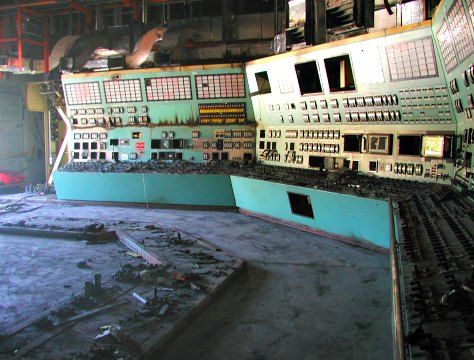The spent fuel will remain there until the federal government establishes a national spent fuel repository or an interim consolidated storage facility. Spent nuclear fuel poses a potential safety and security hazard, so ODOE helps mitigate the potential threat through preparedness.
History of Trojan
The Trojan Nuclear Power Plant was Oregon’s only commercial nuclear power plant. In 1967, majority owner Portland General Electric announced it was going to build the nuclear power plant at the site of the former Trojan Powder Company, about 40 miles northwest of Portland along the Columbia River in Columbia County.
Construction on the $450 million plant began in July 1968, and PGE received a site certificate in July 1971 from the state’s Nuclear and Thermal Energy Council, the predecessor to our Energy Facility Siting Council.
Trojan began generating commercial power on May 20, 1976, with a capacity of 1,130 megawatts. The plant was licensed to run for 30 years and was the largest plant of its kind at the time.
From the outset, the plant was plagued by design flaws and other problems that led to temporary closures and expensive repairs. In 1977, PGE discovered Trojan had been compromised during construction. Walls in the control building were missing crucial reinforcing rods. The control building housed the control room and the electrical equipment that controlled the plant. Trojan was shut down for eight months to complete upgrades that brought it into compliance with federal earthquake protection standards.
Despite its challenges, Trojan received generally strong grades from the U.S. Nuclear Regulatory Commission. In 1984, NRC ratings began to slip and the plant received below average ratings. In 1989, PGE replaced its entire Trojan management. By 1990 and 1992, Trojan again received strong ratings from the NRC, though it did receive a $280,000 fine from the NRC for a problem with the emergency core cooling system.
In 1991, during the plant’s annual refueling outage, electronic probes in the plant’s steam generator tubes showed that cracks were developing faster than expected. At the NRC’s direction, PGE launched a major steam generator tube investigation and repair program that lasted for several months. In February 1992, the NRC allowed PGE to reopen Trojan.
Much of this occurred in the midst of efforts by anti-nuclear groups to close Trojan. Initiatives on the ballot in 1986 and 1990 that would effectively close the plant were defeated. Two additional measures were on the ballot in 1992. In August of that year, PGE announced it would close Trojan prematurely in 1996 rather than replace the steam generators. The 1992 ballot measures to close Trojan were defeated by Oregon voters.
Just one week after the election, a leak developed in a steam generator tube. It was a small leak and was only detectable using very sensitive instruments that were installed just for that purpose. The leak was well within the plant’s Safety Analysis, making it acceptable to continue plant operation. PGE chose to shut the plant down so they could investigate. The plant never reopened.

On January 27, 1993 PGE notified the Oregon Department of Energy and the NRC of its decision to permanently close Trojan. That began a decade-long process to decommission the plant. The reactor vessel and steam generators were shipped by barge up the Columbia River for burial at the US Ecology commercial low-level waste site located at Hanford near Richland, Washington. The containment building was demolished and the cooling tower imploded. Most of the radioactive waste was hauled to the US Ecology site for burial.
In 2003, PGE transferred Trojan’s 791 spent nuclear fuel assemblies to dry casks. The 34 dry casks are large concrete and steel canisters that sit upright on a concrete pad within Trojan’s protected area, known as an ISFSI – an Independent Spent Fuel Storage Installation.
This spent nuclear fuel will remain at the Trojan site until the federal government has a central place to put nuclear and radioactive waste. The U.S. Department of Energy has defaulted on agreements with nuclear utilities all across the country to begin accepting spent fuel for disposal; they had previously agreed to begin accepting the fuel in 1998. The intent was for it to go to a national geologic repository at Yucca Mountain, Nevada. Because the federal government has not been able to meet its requirements and open a repository it was widely sued. As part of the settlements, it is reimbursing PGE for the security costs and other costs associated with storing this fuel on site.
Regulations require that the site be cleaned to a level of residual radiation that is "as low as reasonably achievable."
Trojan was built on an industrial site, and is now safe again for any type of use, including industrial, commercial, or even residential.
Following the 1979 accident at the Three Mile Island nuclear power plant, Oregon voters passed an initiative in November 1980 that prohibits the licensing of a new nuclear power plant unless it is approved by the voters – and only if there is a permanent national repository for disposal of high-level waste in place.
Trojan Decommissioning Timeline
| 1993 | Portland General Electric announces it will permanently close Trojan |
1995
| Removal of large components (4 steam generators and the pressurizer). |
| 1996 | Energy Facility Siting Council (EFSC) and Nuclear Regulatory Commission (NRC) approval of the Decommissioning Plan. |
| 1999 | Approval of planned "independent spent fuel storage installation." |
| 1999 | One-piece removal of the reactor vessel and its internal components (a first in the nation). |
| 2000 | ODOE and NRC review of the final survey plan. |
| 2001 | Start of final survey. |
| 2003 | All spent fuel transferred from the spent fuel pool to dry cask storage. |
| 2004 | Portland General Electric completed the final survey and submitted all results to ODOE and NRC for review. |
| 2005 | NRC and EFSC approval for releasing the site. |
| 2006 | Trojan's
cooling tower demolished. |